
Sir Harry Paget Flashman is a fictional character created by Thomas Hughes (1822–1896) in the semi-autobiographical Tom Brown's School Days (1857) and later developed by George MacDonald Fraser (1925–2008). Harry Flashman appears in a series of 12 of Fraser's books, collectively known as The Flashman Papers, with covers illustrated by Arthur Barbosa and Gino D’Achille. Flashman was played by Malcolm McDowell in the Richard Lester 1975 film Royal Flash.
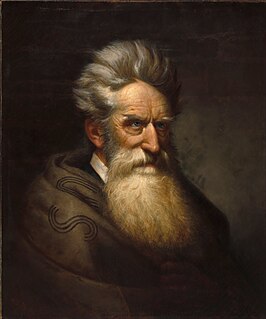
John Brown was an American abolitionist leader. First reaching national prominence for his radical abolitionism and fighting in Bleeding Kansas, he was eventually captured and executed for a failed incitement of a slave rebellion at Harpers Ferry preceding the American Civil War.
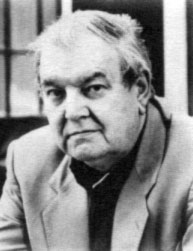
George MacDonald Fraser was a British author and screenwriter. He is best known for a series of works that featured the character Flashman.
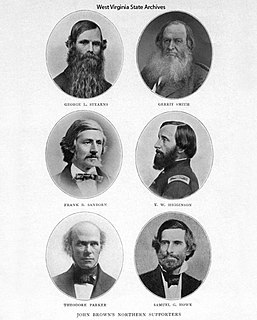
The so-called Secret Six, or the Secret Committee of Six, were a group of men who secretly funded the 1859 raid on Harper's Ferry by abolitionist John Brown. Sometimes described as "wealthy," this was true of only two. The other four were in positions of influence, and could, therefore, encourage others to contribute to "the cause."
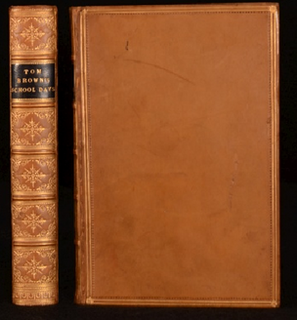
Tom Brown's School Days is an 1857 novel by Thomas Hughes. The story is set in the 1830s at Rugby School, an English public school. Hughes attended Rugby School from 1834 to 1842.

Royal Flash is a 1975 British adventure film based on the second Flashman novel by George MacDonald Fraser. It stars Malcolm McDowell as Flashman. Additionally, Oliver Reed appeared in the role of Otto von Bismarck, Alan Bates as Rudi von Sternberg, and Florinda Bolkan played Lola Montez. Fraser wrote the screenplay and the film was directed by Richard Lester.
Tom Brown is a fictional character created by author Thomas Hughes in his work Tom Brown's School Days (1857) which is set at a real English public school—Rugby School for Boys—in the 1830s when Hughes himself had been a pupil there. Tom Brown is based on the author's brother, George Hughes, and George Arthur is based on Arthur Penrhyn Stanley.
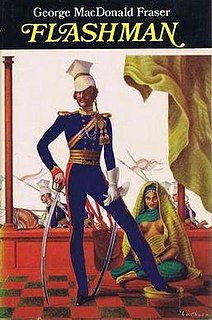
Flashman is a 1969 novel by George MacDonald Fraser. It is the first of the Flashman novels.

Flash for Freedom! is a 1971 novel by George MacDonald Fraser. It is the third of the Flashman novels.
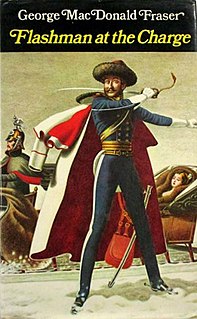
Flashman at the Charge is a 1973 novel by George MacDonald Fraser. It is the fourth of the Flashman novels. Playboy magazine serialised Flashman at the Charge in 1973 in their April, May and June issues. The serialisation is unabridged, including most of the notes and appendixes and features a few illustrations, collages from various paintings and pictures to depict a period montage of the Charge and Crimea.

Flashman in the Great Game is a 1975 novel by George MacDonald Fraser. It is the fifth of the Flashman novels.

Flashman's Lady is a 1977 novel by George MacDonald Fraser. It is the sixth of the Flashman novels.

Flashman and the Redskins is a 1982 novel by George MacDonald Fraser. It is the seventh of the Flashman novels.

Flashman and the Dragon is a 1985 novel by George MacDonald Fraser. It is the eighth of the Flashman novels.
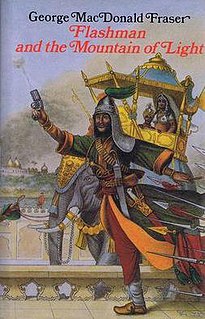
Flashman and the Mountain of Light is a 1990 novel by George MacDonald Fraser. It is the ninth of the Flashman novels.
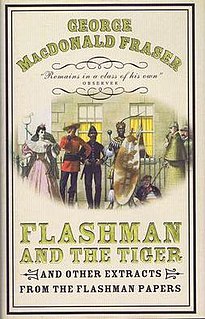
Flashman and the Tiger is a 1999 book by George MacDonald Fraser. It is the eleventh of the Flashman books.

Flashman on the March is a 2005 novel by George MacDonald Fraser. It is the twelfth and last Flashman novel.
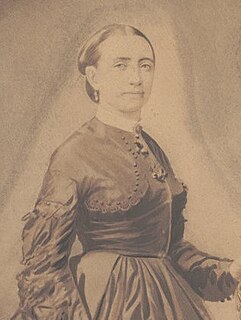
Kate Warne was an American law enforcement officer known as the first female detective, in 1856, in the Pinkerton Detective Agency and the United States.

The Flashman Papers is a series of novels and short stories written by George MacDonald Fraser, the first of which was published in 1969. The books centre on the exploits of the fictional protagonist Harry Flashman. He is a cowardly British soldier, rake and cad who is placed in a series of real historical incidents between 1839 and 1894. While the incidents and much of the detail in the novels have a factual background, Flashman's actions in the stories are either fictional, or Fraser uses the actions of unidentified individuals and assigns them to Flashman. Flashman is a character in the 1857 novel by Thomas Hughes, Tom Brown's School Days; Hughes' version of the character is a bully at Rugby School who is expelled for drunkenness. The character was then developed by Fraser, and appeared in the 1969 novel Flashman. Fraser went on to write a total of eleven novels and one collection of short stories featuring the character.
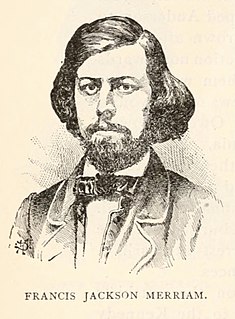
Francis Jackson Meriam was an American abolitionist, born on November 17, 1837, in Framingham, Massachusetts, and died on November 28, 1865, in New York City. He was named for his grandfather, Francis Jackson, who had been president of the American Anti-Slavery Society. Hinton describes him as "handsome, well-to-do, cultivated, and traveled". Instead of college, he lived in Paris for some time. In contrast, Sanborn described him as "enthusiastic and resolute, but with little judgment, and in feeble health; altogether, one would say, a very unfit person to take part actively in Brown’s enterprise." He was blind in one eye.



















